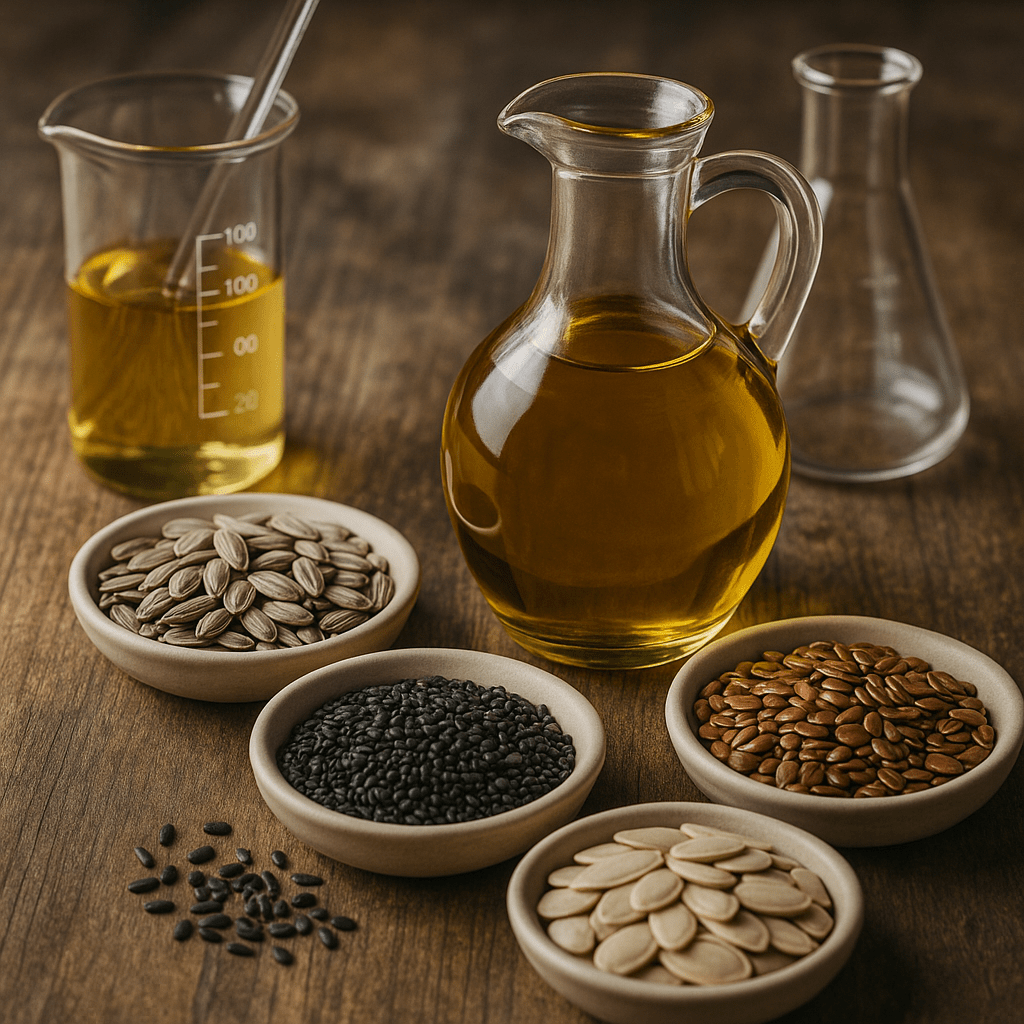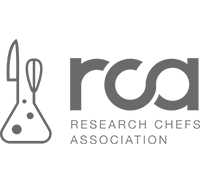Helmsman Group
Seed Oils: Friend or Foe? The Science Behind the Controversy
By Mark Haas | Food Science Innovator & Nutrition Research Expert | Helping brands balance nutrition science, culinary excellence, and market viability
The Great Seed Oil Debate
Scroll through any health or nutrition-focused social media feed today and you’ll likely encounter passionate warnings about seed oils. These common cooking oils—canola, soybean, sunflower, and corn oil among others—have been labeled everything from “toxic” to “the root cause of modern disease epidemics.” But how much of this backlash is based on sound science, and how much stems from misunderstanding?
“The demonization of any single food component rarely captures the complexity of human nutrition. Seed oils are no exception.” — As I noted in my previous research on dietary patterns and health outcomes
The conversation around seed oils has grown increasingly polarized, with influencers and nutrition personalities taking hardline stances. On one side, you’ll find claims that these oils are “industrial sludge” responsible for the modern chronic disease epidemic. On the other, defenders assert they’re perfectly benign or even heart-healthy additions to any diet.
The reality, as with most nutrition topics, lies somewhere in the middle—and depends significantly on context, quality, genetic factors, and overall dietary patterns. This article aims to provide a balanced, evidence-based examination of what contemporary nutrition science actually tells us about these ubiquitous cooking oils.
What Are Seed Oils, Really?
Seed oils are vegetable oils extracted primarily from the seeds of plants. Their rise to prominence in the 20th century coincided with agricultural industrialization and public health campaigns aimed at reducing saturated fat consumption (Blasbalg et al., 2011). These oils are characterized by their high polyunsaturated fatty acid (PUFA) content, particularly linoleic acid—an essential omega-6 fatty acid that our bodies cannot produce internally.
Common seed oils include:
-
Canola oil (rapeseed)
-
Soybean oil
-
Sunflower oil
-
Safflower oil
-
Corn oil
-
Cottonseed oil
The Scientific Perspective: Separating Fact from Fiction
Essential Nutrition
Despite their controversial reputation, omega-6 fatty acids are classified as essential nutrients by the National Institutes of Health. Our bodies require linoleic acid for maintaining cell membranes, supporting brain function, and regulating numerous physiological processes.
What many critics overlook is the biological necessity of these fatty acids. Linoleic acid serves as a precursor for arachidonic acid, which in turn produces eicosanoids—signaling molecules that regulate inflammation, blood pressure, and blood clotting. Without adequate linoleic acid, our bodies cannot synthesize these crucial compounds.
The American Heart Association and the Academy of Nutrition and Dietetics recommend consuming between 5-10% of total daily calories from omega-6 fatty acids—an amount easily obtained through a balanced diet that includes moderate seed oil consumption.
Cardiovascular Health Evidence
The scientific literature predominantly supports the heart-healthy profile of PUFAs found in seed oils:
“Substituting polyunsaturated fats for saturated fats is associated with reduced LDL cholesterol levels and lower risk of cardiovascular events.” — Mozaffarian et al., 2010
This isn’t an isolated finding. A landmark meta-analysis published in PLOS Medicine examined data from 60 controlled trials involving 129,321 participants and found that replacing just 5% of calories from saturated fats with polyunsaturated fats reduced coronary heart disease risk by approximately 10%.
A comprehensive 2024 umbrella review analyzing multiple meta-analyses confirmed the cardiovascular benefits of various edible oils, including several seed oils (Pan et al., 2024). This review found consistent evidence that seed oils improved key biomarkers associated with cardiovascular health, including:
-
Decreased LDL cholesterol levels
-
Improved LDL:HDL cholesterol ratio
-
Reduced triglyceride concentrations
-
Lower markers of oxidative stress
The Inflammation Question
Perhaps the most persistent claim against seed oils is that they promote inflammation. However, this assertion doesn’t align with the bulk of clinical research:
“Controlled trials investigating the effects of linoleic acid consumption on inflammatory markers show minimal impact at normal dietary levels,” notes a systematic review by Johnson & Fritsche (2012).
To understand this apparent contradiction, we need to examine the biochemical pathways involved. While omega-6 fatty acids can theoretically be converted to pro-inflammatory compounds, the human body has sophisticated regulatory mechanisms that typically prevent excessive inflammatory responses from dietary linoleic acid alone.
A 2021 randomized controlled trial published in the Journal of the American College of Cardiology examined the effects of high linoleic acid consumption (from sunflower oil) compared to olive oil. The researchers found no significant differences in inflammatory biomarkers including C-reactive protein (CRP), interleukin-6 (IL-6), or tumor necrosis factor-alpha (TNF-α).
Even long-term supplementation studies with polyunsaturated fats have failed to demonstrate significant pro-inflammatory effects in healthy individuals. In fact, some research suggests that in certain contexts, linoleic acid metabolites can exhibit anti-inflammatory properties through specialized pro-resolving mediators (SPMs).
Oxidation and Heat Stability
A legitimate concern regarding seed oils involves their vulnerability to oxidation. Polyunsaturated fats contain multiple double bonds in their chemical structure, making them more susceptible to oxidative damage when exposed to heat, light, and air compared to more saturated fats.
When oils oxidize, they can form potentially harmful compounds including aldehydes and hydroperoxides. However, several important contextual factors must be considered:
-
Cooking method matters significantly: Brief sautéing or stir-frying at moderate temperatures causes minimal oxidation compared to deep-frying, especially repeated deep-frying.
-
Refined oils contain fewer compounds that accelerate oxidation: Commercial refinement processes remove many compounds (like chlorophyll) that can catalyze oxidation reactions.
-
Antioxidant content varies: Some seed oils, particularly cold-pressed varieties, naturally contain vitamin E and other antioxidants that help prevent oxidative damage.
Genetic Variability and Personalized Response
An emerging area of nutrition science suggests that individual genetic differences may influence how people respond to different dietary fats. Variations in genes like FADS1 and FADS2, which encode enzymes involved in fatty acid metabolism, can affect how efficiently your body processes linoleic acid.
Research from the field of nutrigenetics suggests that approximately 30% of the population may have genetic variants that result in more efficient conversion of linoleic acid to arachidonic acid. These individuals might indeed benefit from moderating their omega-6 intake while increasing omega-3 consumption.
This genetic variability might explain why observational studies sometimes yield conflicting results regarding seed oil consumption and health outcomes. What’s optimal for one person may not be ideal for another—a principle increasingly recognized in precision nutrition approaches.
How Did Seed Oils Become Dietary Villains?
The Industrial Process Concern
Many seed oil critics point to industrial extraction methods, particularly the use of hexane solvents, as problematic. It’s worth examining this concern in detail:
Modern extraction typically involves:
-
Cleaning and preparing the seeds (dehulling, flaking)
-
Extraction using mechanical pressing and/or solvent extraction (typically hexane)
-
Refining processes including degumming, neutralization, bleaching, and deodorization
-
Packaging and distribution
The primary concern centers on hexane, a petroleum-derived solvent. However, FDA regulations strictly limit hexane residues in finished products (21 CFR §172.860), with typical concentrations well below levels of health concern—often less than 0.8 parts per million. Independent testing has consistently found commercial oils to contain negligible hexane residues, far below levels that would pose health risks.
“The dose makes the poison. At the minute quantities found in commercial seed oils, hexane poses no demonstrated health risk.” — From Journal of Food Science and Technology, 2022
Beyond solvent concerns, the refining process does remove some beneficial compounds found in unrefined oils, including certain antioxidants, phytosterols, and micronutrients. This is a legitimate trade-off: refined oils offer greater stability and higher smoke points but potentially fewer beneficial minor components.
Guilty by Association
Seed oils frequently appear in ultra-processed foods—a legitimate dietary concern. The NOVA classification system, developed by researchers at the University of São Paulo and now widely used in nutritional epidemiology, categorizes many foods containing seed oils as “ultra-processed.”
However, correlation is not causation. Research suggests the health risks of these foods stem from their overall poor nutritional profile, excessive calories, and additives rather than specifically from the oils used (Monteiro et al., 2019).
A 2023 systematic review examining the relationship between ultra-processed food consumption and health outcomes found that the strongest associations were with:
-
Added sugar content
-
Sodium levels
-
Caloric density
-
Low fiber content
-
Absence of protective nutrients
The presence of seed oils alone didn’t correlate with negative health outcomes when controlling for these other factors.
The Appeal to Ancestral Diets
Arguments against seed oils often reference their absence in traditional human diets. While historically accurate, this perspective sometimes romanticizes pre-industrial nutrition while overlooking its limitations—including shorter lifespans and numerous nutritional challenges.
Ancestral eating patterns varied tremendously across geography and time periods. Some traditional cultures consumed relatively high amounts of polyunsaturated fats from nuts, seeds, and certain animal sources. The Tsimané people of Bolivia, often cited for their remarkable cardiovascular health, consume approximately 14% of calories from polyunsaturated fats—comparable to modern recommendations.
It’s also worth noting that pre-agricultural human diets typically featured substantially higher amounts of omega-3 fatty acids from wild plants and animals, creating a naturally balanced omega-6:omega-3 ratio regardless of the absolute intake of either fatty acid type.
Social Media Amplification
The rapid rise of seed oil skepticism coincides with the evolution of social media algorithms that reward controversial content and simple narratives. Complex nutritional science doesn’t easily translate to viral TikTok videos or Instagram reels.
The seed oil controversy exemplifies what researchers call “nutrient-centrism”—the tendency to focus on individual nutrients rather than overall dietary patterns. This reductionist approach has historically led to pendulum swings in nutritional advice, from the low-fat era of the 1980s-90s to the current enthusiasm for high-fat, low-carbohydrate approaches.
Finding Balance: A More Nuanced Approach
The Omega Balance
The ratio of omega-6 to omega-3 fatty acids in modern diets deserves attention. Many nutrition researchers suggest maintaining this ratio below 4:1 for optimal health (Simopoulos, 2008), yet estimates suggest the average American diet contains a ratio closer to 15:1 or even 20:1.
This imbalance merits consideration for several reasons:
-
Both omega-6 and omega-3 fatty acids compete for the same enzymatic pathways
-
Metabolites from each pathway have differing (sometimes opposing) physiological effects
-
Western diets have seen dramatic increases in omega-6 intake concurrent with decreases in omega-3 consumption
A 2020 meta-analysis of 38 randomized controlled trials found that reducing the omega-6:omega-3 ratio was associated with decreased inflammatory markers in subjects with metabolic syndrome, though effects were modest in healthy populations.
However, the solution isn’t necessarily eliminating seed oils but rather implementing a more balanced approach:
-
Increasing omega-3 consumption (from fatty fish, flaxseeds, walnuts)
-
Using a variety of cooking fats, including olive oil and moderate amounts of quality animal fats
-
Focusing on whole, minimally processed foods overall
-
Selecting higher-quality seed oils when using them (see below)
Quality and Processing Considerations
Not all seed oils are created equal. The quality spectrum extends from industrially refined, mass-produced oils to carefully produced, cold-pressed, and minimally processed versions. These differences matter significantly:
Extraction Method Impact:
-
Cold-pressed oils retain more natural antioxidants (tocopherols)
-
Lower-temperature processing preserves more phytonutrients
-
Minimal processing typically means fewer chemical additives
Refinement Trade-offs:
-
Refined oils have higher smoke points, making them more versatile for cooking
-
Unrefined oils typically offer richer flavor profiles and greater nutritional value
-
Semi-refined options present a middle ground
Storage and Handling: “Oil degradation primarily occurs under conditions of repeated high-heat commercial deep frying—conditions rarely replicated in home cooking,” explains food scientist Robert Stier (2013).
Proper storage significantly extends oil quality and reduces oxidation:
-
Store oils in dark bottles away from direct light
-
Keep oils away from heat sources
-
Use within reasonable timeframes (3-6 months after opening for most seed oils)
-
Consider refrigeration for particularly delicate oils
Special Consideration: High-Oleic Varieties
A relatively recent development deserving special mention is the widespread availability of high-oleic versions of traditional seed oils. Through conventional breeding techniques (not genetic modification), these varieties contain significantly higher amounts of monounsaturated fat (oleic acid—the same predominant fatty acid in olive oil) and lower polyunsaturated fat content.
High-oleic sunflower, safflower, and canola oils offer:
-
Greater heat stability
-
Reduced susceptibility to oxidation
-
Improved fatty acid profiles comparable to olive oil
-
Neutral flavor profiles suitable for diverse culinary applications
Research from the Agricultural Research Service (ARS) demonstrates that high-oleic varieties show substantially reduced oxidation markers even under high-heat cooking conditions compared to their conventional counterparts.
The Bigger Picture: Context Matters Most
Extensive research on dietary patterns consistently shows that plant-forward diets incorporating diverse fats—yes, including moderate amounts of seed oils—correlate with reduced disease risk and increased longevity (Willett et al., 2019).
The most robust evidence in nutrition science points to the importance of:
-
Overall dietary patterns rather than individual ingredients
-
Food quality and minimal processing
-
Dietary diversity and balance
-
Portion awareness and energy balance
The Bigger Nutritional Context: Beyond Single Ingredients
Before discussing specific recommendations, it’s crucial to understand seed oils within broader dietary patterns. Nutritional epidemiology consistently demonstrates that overall dietary patterns exert far greater influence on health outcomes than individual foods or nutrients.
The Mediterranean and traditional Japanese dietary patterns—both associated with exceptional longevity and low chronic disease rates—include moderate amounts of various plant oils while emphasizing:
-
High vegetable and fruit consumption
-
Regular inclusion of legumes and whole grains
-
Modest protein intake, primarily from plant sources and fish
-
Limited ultra-processed food consumption
-
Cultural practices that promote moderation and mindful eating
A landmark analysis published in The Lancet examining dietary factors across 195 countries found that suboptimal diet was responsible for more deaths than any other risk factor globally (Willett et al., 2019). The primary dietary issues identified were:
-
Insufficient intake of protective foods (whole grains, fruits, vegetables, nuts, seeds, legumes)
-
Excessive consumption of sodium, processed meats, and sugar-sweetened beverages
The presence or absence of seed oils barely registered in this comprehensive analysis of global dietary risk factors.
Making Evidence-Based Choices
For those navigating conflicting information about seed oils, consider these evidence-based approaches:
-
Diversify your fats: Incorporate olive oil, avocado oil, and small amounts of quality animal fats alongside moderate seed oil consumption. Different fats offer different fatty acid profiles and bioactive compounds.
-
Read labels thoughtfully: If minimizing seed oils is your preference, become familiar with processed food ingredients. Focus particularly on ultra-processed foods where seed oils appear alongside multiple additives, high sugar content, and refined carbohydrates.
-
Focus on whole foods: Building meals around vegetables, fruits, legumes, whole grains, and quality proteins naturally reduces reliance on any single fat source while providing essential nutrients and dietary fiber.
-
Consider oil quality: When using seed oils, opt for cold-pressed, unrefined versions when possible and store them properly away from light and heat. High-oleic varieties offer improved stability for high-heat cooking applications.
-
Balance omega fatty acids: Increase omega-3 consumption through regular fatty fish intake (salmon, mackerel, sardines), flaxseeds, chia seeds, and walnuts to improve your overall fatty acid profile.
-
Practice cooking method awareness: Match your oil choice to your cooking method. High-heat cooking (frying, roasting above 375°F) benefits from oils with higher smoke points and greater oxidative stability.
Special Populations and Considerations
Some individuals may indeed benefit from more carefully monitoring seed oil consumption:
-
Autoimmune conditions: Some clinical evidence suggests that certain autoimmune conditions may respond favorably to dietary approaches that moderate omega-6 intake while increasing omega-3s, particularly for rheumatoid arthritis and multiple sclerosis.
-
Metabolic syndrome: Preliminary research indicates that individuals with insulin resistance may experience improved metabolic markers when reducing dietary linoleic acid and increasing omega-3 fatty acids.
-
Genetic variations: As mentioned earlier, those with specific FADS gene variants may process omega-6 fatty acids differently and potentially benefit from personalized approaches.
However, even in these populations, complete elimination of seed oils is rarely necessary or supported by clinical evidence. Moderation and overall dietary quality remain the guiding principles.
A Personal Note on Balance
In my own kitchen, I primarily use extra virgin olive oil, occasionally supplement with high-oleic sunflower oil for high-heat cooking, and include modest amounts of quality animal fats like grass-fed butter. This approach balances nutrition science with culinary tradition and personal preference—a middle ground often missing from polarized nutrition debates.
This balanced perspective comes from years of examining nutrition research and observing that extremism in dietary guidance rarely withstands the test of time. Nutrition science continues to evolve, revealing increasing complexity in how foods interact with our unique bodies and genetic backgrounds.
The truth about seed oils isn’t black and white. Like most nutrition topics, the answer lies in context, quality, and moderation rather than absolute claims. By understanding the science behind the headlines and adopting a nuanced perspective, we can make more informed choices aligned with our individual health goals and values.
As I often tell my clients: “No single ingredient makes or breaks a diet. It’s the pattern that matters most.”
References:
-
Blasbalg TL, et al. “Changes in consumption of omega-3 and omega-6 fatty acids in the United States during the 20th century.” Am J Clin Nutr, 2011.
-
Mozaffarian D, et al. “Effects on coronary heart disease of increasing polyunsaturated fat in place of saturated fat: a systematic review and meta-analysis of randomized controlled trials.” PLoS Med, 2010.
-
Johnson GH, Fritsche K. “Effect of dietary linoleic acid on markers of inflammation in healthy persons: a systematic review of randomized controlled trials.” J Acad Nutr Diet, 2012.
-
Monteiro CA, et al. “Ultra-processed foods: what they are and how to identify them.” Public Health Nutr, 2019.
-
Simopoulos AP. “The importance of the omega-6/omega-3 fatty acid ratio in cardiovascular disease and other chronic diseases.” Exp Biol Med, 2008.
-
Stier RF. “Ensuring the health and safety of fried foods.” Food Technol, 2013.
-
Willett WC, et al. “Food in the Anthropocene: the EAT–Lancet Commission on healthy diets from sustainable food systems.” Lancet, 2019.
For further reading, visit the American Heart Association’s dietary guidance or review the World Health Organization’s nutritional recommendations.
About the Author: Mark Haas is CEO of The Helmsman Group, specializing in helping mid-market CPG brands navigate market turbulence through strategic agility and data-driven decision-making powered by InsightSuites™, their proprietary consumer intelligence platform.






